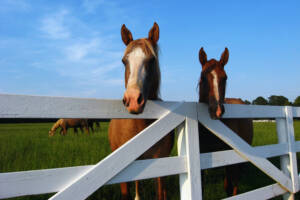Evacuating Large Animals & Livestock
Preparing horses for a wildfire evacuation requires an extra level of planning, preparedness and practice. Building an evacuation kit for each horse, and having a plan for them that’s been practiced, increases the potential your horse(s) will be able to leave when you do. If the wildfire’s proximity does not permit the time needed to load horses, it’s best to turn them loose and not leave them confined in a barn or pasture. Close the doors and gates so they can’t re-enter the area.
EVACUATION PREPAREDNESS FOR HORSES
 Practicing your evacuation route using your horse trailer ensures it’s compatible with the road’s width and grade on each potential exit route from your home. A stuck trailer could prevent others from using the same path to safely evacuate. It’s important to know any limitations before leaving your property during a wildfire. Always take into consideration that large animals take extra time to evacuate. If you don’t have trailer space for all your horses, have a plan that includes neighbors, friends or relatives that have trailers and can help; or identify an animal emergency response team, or for hire service that will assist with short notice.
Practicing your evacuation route using your horse trailer ensures it’s compatible with the road’s width and grade on each potential exit route from your home. A stuck trailer could prevent others from using the same path to safely evacuate. It’s important to know any limitations before leaving your property during a wildfire. Always take into consideration that large animals take extra time to evacuate. If you don’t have trailer space for all your horses, have a plan that includes neighbors, friends or relatives that have trailers and can help; or identify an animal emergency response team, or for hire service that will assist with short notice.
Being familiar with what to expect in a wildfire evacuation, knowing how and when to leave and building an evacuation kit for each horse will expedite leaving safely when fires happen.
If you’re unable to evacuate with the horse, but have time, using one of the methods below may help animal rescuers reunite you quicker with the horse:
-
- Use a livestock crayon to write your name, phone number and address on the horse
- With clippers shave your phone number into the horse’s coat
- Braid a temporary ID tag with pre-written contact info into the horse’s mane
- Attach a neck band
If you must leave your animals, leave them in a preselected, cleared area. Leave enough hay for 48 to 72 hours. Do not rely on automatic watering systems. Power may be lost.
One way to easily store important information you may need for your horses is to scan the recommended documents and photos on the checklist and keep them on a flash drive that’s permanently stored inside the evacuation kit. Consider having two identical flash drives and give one to a friend or relative that lives in a neighboring community; that will help provide the information you need if there wasn’t time to grab your kit when the public alert was received.
Do not wait until the last minute to start evacuating!
Resource credit: CAL FIRE and FIRESafe MARIN
